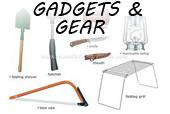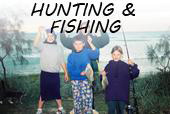Fishing is the most popular sport in the world and can be a very fun, relaxing venture. In order to gain the full experience, the correct fishing tackle must be used. Fishing tackle, is essentially all the accessories one uses, when fishing. Fishing tackle ranges from the fishing rod, the line, weights, bait and even to the little stool you sit on. Each of the different fishing tackles co-ordinately works alongside one other, in order for the fisherman to fish. This article will give a brief overview of the main types of fishing tackle that you will come across.
The “fishing rod” is the fundamental attribute to fishing tackle and is used to catch fish. The fishing pole attaches the fishing reel and wire, which ultimately reels in the fish; if you’re lucky enough to catch one, that is. Fishing rods vary by size and are made from many different materials such as fibreglass and carbon fibre. This type of fishing tackle is influenced a great deal by the environment of the fishing carried out. For deep sea fishing, where on average larger, stronger fish swim; one must use a longer, thicker rod with a very thick, weighted line. The hook must also be very large and sharp enough to penetrate the fish’s mouth.
The “hook” and the “fishing line” are major elements found in fishing tackle. They are greatly influenced by the type of fishing carried out. Bigger hooks and thicker, weighted lines are used in saltwater, sea fishing, where swordfish and sharks are caught for example. Whereas, on the other hand, smaller hooks with thinner, lighter lines are used in freshwaters to catch fish such as carp and bass. However, this is merely an overview; obviously there are circumstances where you would need thick and weighted lines and bigger hooks to catch large freshwater fish. This therefore shows that fishing is a very unpredictable and exciting sport where the right fishing tackle is constantly needed in order to catch the right type of fish you are fishing.
Significantly different fishing tackle is used when fishing in freshwater or saltwater, in regards to the bait used. Fishing tackle can either be live, dead of artificial. For freshwater fishing, grubs and the garden worms usually work best. Whilst for saltwater fishing, sea worms, crabs and mullets are used. In my experience of fishing live bait always works best. The vibrations of a squirming tackle at the end of your hook will attract a lot more fish than a dead, or artificial bait would. In my personal view adding live bait to your fishing tackle adds a whole new element in fishing. In nature the small get eaten by the big. In our case the small will get eaten by the bigger fish, but ultimately we would catch the bigger fish, metaphorically making us the bigger fish to the once, big fish.
From this overview of fishing tackle it is possible to understand what fishing tackle is and the importants of having different tackle when it comes to carrying out different types of fishing, whether it is freshwater of saltwater.












